|
The Racing Years Because Edward Lisle had been a
keen and successful competitor in local cycle races
during his earlier years, it was almost inevitable that
Star cars would take part in competitions and trials.
His sons Dick and Joseph became keen racing drivers
and achieved a number of victories in the company’s
cars.
The first major road race held in
England was the 1,000 Miles Trial in April and May 1900
which included a Star-Benz. The car successfully
completed the course and was praised in the motoring
press. Star-Benz cars also competed in hill climbs
organised by the Wolverhampton and District Automobile
Club, where they met with some success.
|
|
The first major international
competition was the Gordon Bennett Race in which cars
competed for the Bennett Trophy. The races, held between
1900 and 1905 were sponsored by Gordon Bennett junior,
son of the Scottish journalist who founded the New York
Herald.
Gordon Bennett junior’s main interests in life
were cars, planes, and women. He used his inheritance to
sponsor the trophy and the races, and in 1906
established a hot-air balloon race.
One of the rules of the race was
that the winning car’s country of origin would be the
venue for the following year’s race. The 1902 event,
held in June of that year, was over a 350 mile course
between Paris and Innsbruck. Three French cars and one
British car competed for the trophy, which was won by
Selwyn Edge in his British Napier. As a result the 1903
race would be held in Great Britain.
The chosen route consisted of
several laps of a figure-of-eight course, starting and
finishing at the town of Athy, about 40 miles south of
Dublin. Covering a distance of 327.5 miles. |
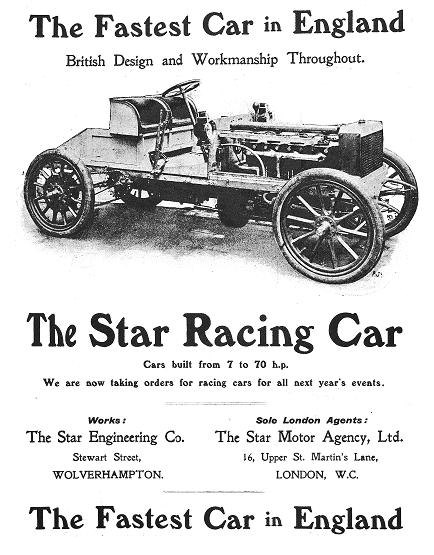
An advert from 1903. |
|
Fired with enthusiasm, Star rose to
the occasion and built the company’s first racing car,
powered by an 80hp. four-cylinder engine, with overhead
inlet valves and side chain drive. The car was to
compete in the eliminating trials for the race, at
Dashwood Hill, Buckinghamshire, and in the grounds of Welbeck Abbey,
Nottinghamshire. The aim of the trials was to select
three British-made cars for the Athy race. On the day,
the Star car, driven by Joseph Lisle, was unsuccessful
against the faster Napiers.
All was not lost however. Edward
Lisle offered the car, now fitted with a four-seater
body, as a course car. Unfortunately things went wrong
when the crew got lost, took the wrong route, and the
car broke down.
The following year saw the
introduction of the ‘Little Star’. Two of them competed
in the small car trials in August and September 1904.
The trials took place over a hilly course in the area
around Hereford, and were organised by the Automobile
Club of Great Britain and Ireland, later to be the RAC.
The two Stars, driven by Joseph Lisle and
F. R. Goodwin
were quite successful, finishing in 4th and 5th
place in their respective classes. |

Harry Goodwin at the wheel of one
of the 70hp. Stars that took part in the Gordon Bennett
eliminating trials on the Isle of Man in 1905. Courtesy
of the late Jim Boulton. |
Edward Lisle hadn’t given-up on the
idea of competing in the Gordon Bennett race. The
eliminating trials for the 1905 race were to be held on
the Isle of Man, and the company set about building two
almost identical cars for the race.
They were based on
the successful 60hp. Mercedes car that had won the
Gordon Bennett race in 1903.
The cars had four-cylinder,
10litre, 70hp. engines and were driven by two brothers,
F. R. and H. G. Goodwin.
Unfortunately the cars were
underpowered, and much slower than the competition, and
so were eliminated. |
|
In 1906 the company decided to
compete in the Isle of Man T.T. and entered two 18hp.
cars, driven by Joseph Lisle and George Prew. All cars
entering the race were only allowed to carry a certain
amount of fuel, calculated using a fuel consumption
formula.
The two Stars each carried 6½ gallons, but both
ran out of fuel during the 160 mile-long race. Prew
succeeded in travelling 104.57 miles and Lisle achieved
98.57 miles.
Star also entered two different
18hp. cars in the following year’s T.T. driven by Harry
Goodwin and George Prew. Again they were unsuccessful.
As in the previous year’s event the amount of fuel
carried was restricted, and with this in mind Goodwin
drove very carefully to conserve fuel.
The race had a
5p.m. deadline, by which time all competitors had to
have crossed the finishing line. At 5p.m. Goodwin was
still on his 5th lap and so was disqualified.
George Prew suffered a much worse fate. His car collided
with Quarter Bridge during the second lap and was badly
damaged.
|
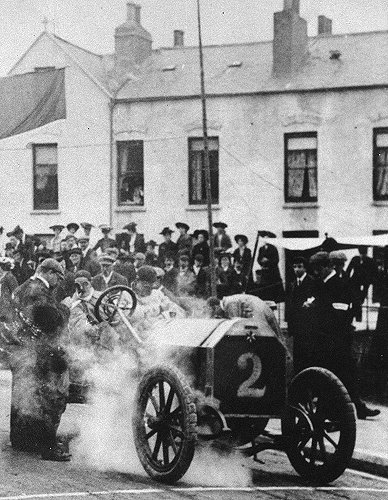
One of the 70hp. Stars begins a
run in the 1905 Gordon Bennett eliminating trials on the
Isle of Man. Courtesy of Peter Lisle. |
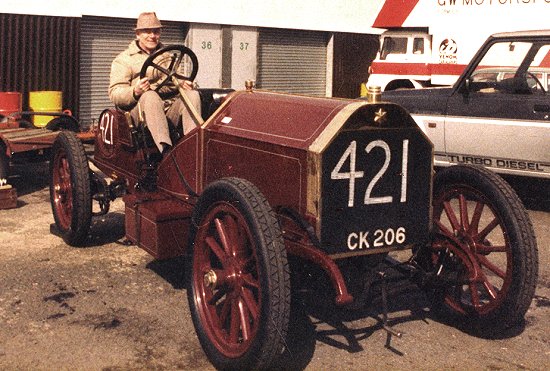 |
Peter Lisle at the wheel of a
1905 Gordon Bennett Star.
The car was rebuilt after the
mechanical parts were discovered in India. The body is
an accurate reproduction.
Courtesy of Peter Lisle. |
| Dick Lisle and a streamlined
12hp. Star racing car outside the works.
Courtesy of Peter Lisle. |
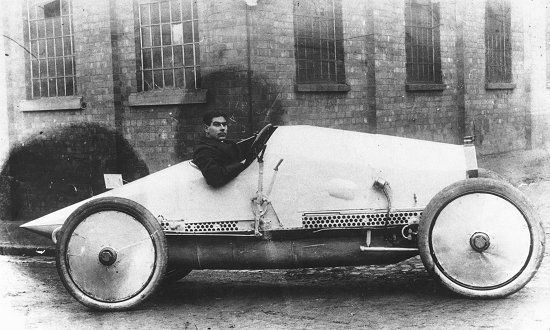 |
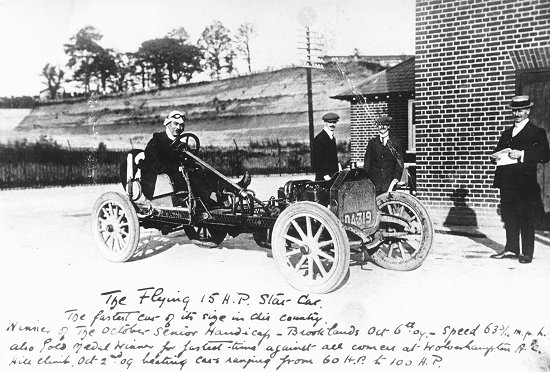 |
Dick Lisle and the 15hp. Star
that won a gold medal in the Wolverhampton Automobile
Club's meeting on October 2nd, 1909.
It also won the 1909 October
Senior Handicap at Brooklands.
Courtesy of Peter Lisle. |
|
During the pre-war years Star cars
enjoyed many successes in reliability trials, sprints
and hill climbs throughout much of the world, competing
in Australia, New Zealand, the Transvaal, Holland,
Ireland, Scotland.
1909 turned-out to be an extremely
successful year in trials and competitions. In
the 1909 Irish Reliability Trial, a Star car achieved
the fastest time on some of the hills. In the 1909
Scottish Automobile Club Trial a 12hp. Star won all of
the hill climbs in its class, and achieved maximum
points in the fuel consumption contest. In the same
trial the new 15hp. model won a special medal, and in
the 1909 October Senior Handicap at Brooklands, Dick
Lisle finished in first place, lapping at 63.75m.p.h. in
his 15hp. Star.
In the 1910 Raglan Cup Races at
Brooklands a Briton car driven by Dick Lisle lapped at
68.47m.p.h. to beat Coatalen’s Sunbeam.
There were also successes abroad. A
Star car won a gold medal in the Dutch Reliability
Trial, and another was successful in the Australian fuel
consumption tests. |
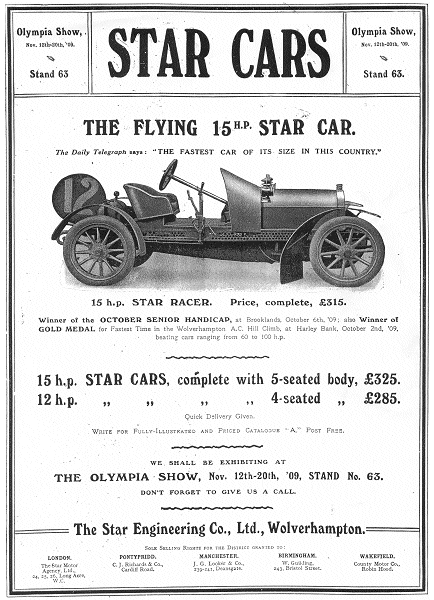
An advert from 1909. |
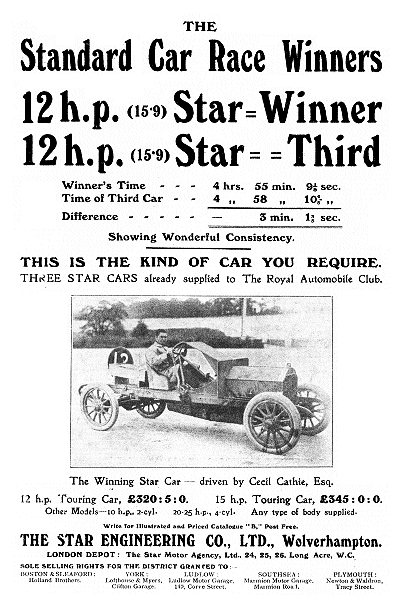
From 'The Motor'. 4th July, 1911.
| One of the company’s greatest
racing achievements was when a 15hp. Star won the 277
mile-long 1911 RAC Standard Cars Race at Brooklands, for
four-cylinder standard cars of up to 15.9hp. There were
24 entries. Cecil Cathie’s Star won the race at an average
speed of 56.5m.p.h. A second Star driven by Dick Lisle
also entered the race and finished in third place. In 1912 the company entered a
20.1hp. car in the race. Sadly it was barred on a
technicality, but the car, driven by Dick Lisle soon
returned to Brooklands to capture twelve records in the
Class ‘E’ event, including an average speed of
66.82m.p.h. over a period of 12 hours.
On 30th August, 1912 Dick Lisle achieved a 12
hours record at Brooklands in a standard 15.9hp.
Star, driving continuously for 801 miles, 1,513
yards. |
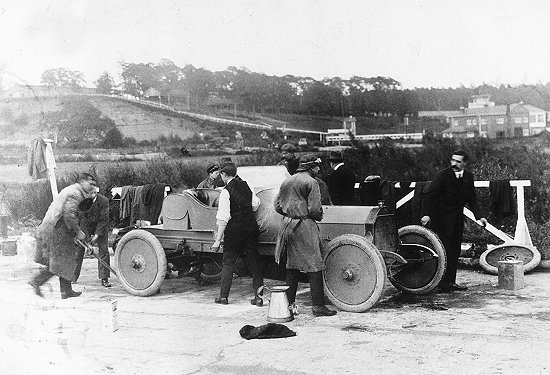 |
The 15.9hp. Star being
serviced during the 12 hour endurance test.
Courtesy of Peter Lisle. |
|
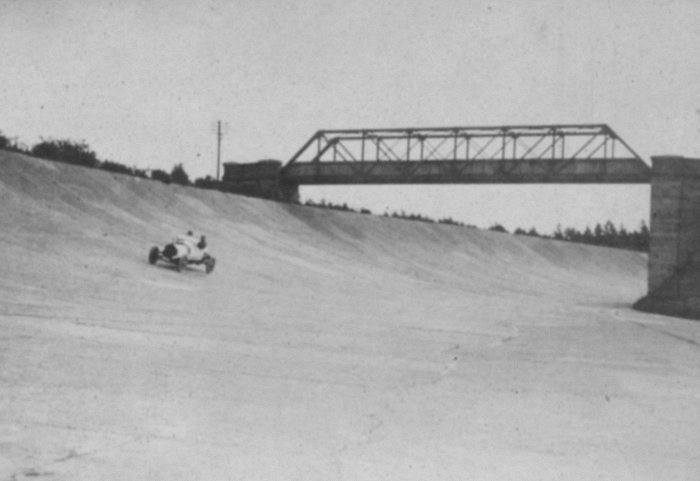
The 15.9hp. Star in action at
Brooklands on 30th August, 1912. |
|
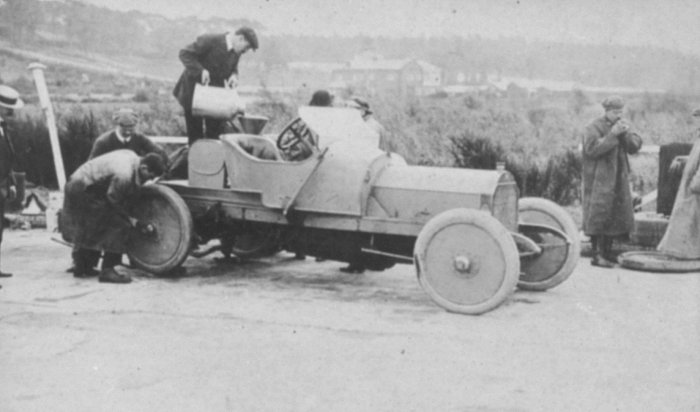
The car is refuelled and
checked over. |
|

Another stop for refuelling,
tyre-changing and a check-over. |
|

The 15.9hp. car gets underway
after a quick service. |
|
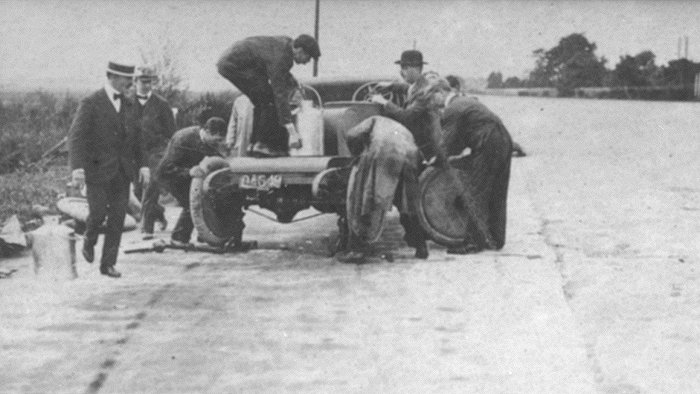
Another view of the service. |
|
In 1914 Star entered two cars in
the Isle of Man T.T.
They were driven by Dick Lisle and
Richard Crossman but were unsuccessful.
Crossman’s race
ended during the fifth lap due to water pump trouble.
Lisle’s also ended in the same lap, when his car
crashed at Ballaugh Bridge.
|
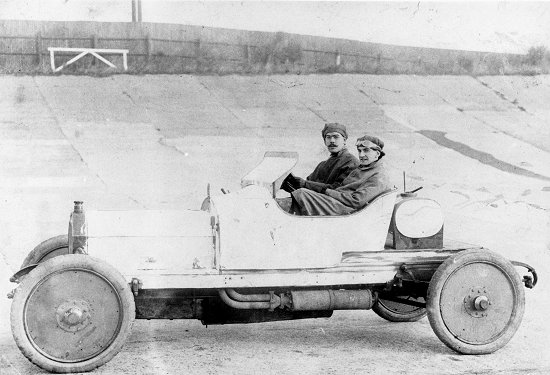
The 15hp. Star that won the Class 'E' event at
Brooklands in 1912. Driven by Dick Lisle. Courtesy of Peter Lisle. |
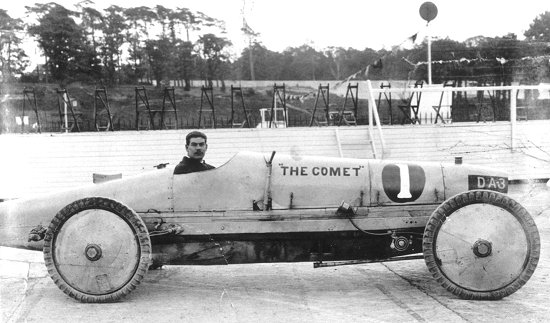 |
Dick Lisle and his 20.1hp.
Star 'Comet' racing car.
Courtesy of Peter Lisle. |
| Dick Lisle and a different
version of his 'Comet'.
Seen outside the works in
Nelson Street.
Courtesy of the late Jim
Boulton. |
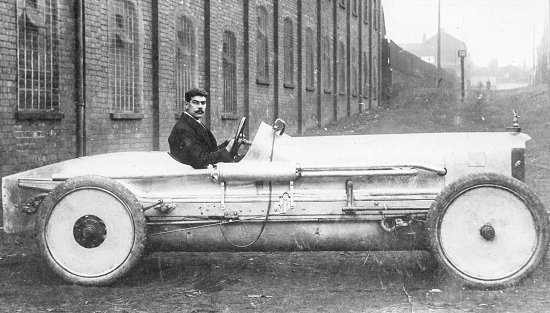 |
| The later 11.9hp. car, introduced
in June 1921 became a successful competitor in club
events and at Brooklands. Two 11.9hp. Stars were entered
in the 1922 Scottish Six Days Light Car Trial and
outclassed the competition. They were driven by Dick
Lisle and Cecil Cathie, one winning the gold medal, the
other coming in second. Cecil Cathie was Star’s chief
tester and works driver. The gold medal winning car went
on to be much-travelled after being sold to a gentleman
in Australia. Once there it was driven for about 11,000
miles, and then purchased by a New Zealander, who entered
it in numerous competitions in New Zealand and broke
many records previously held by larger cars.
A few of Dick Lisle's many cups and
trophies from before the First World War: |
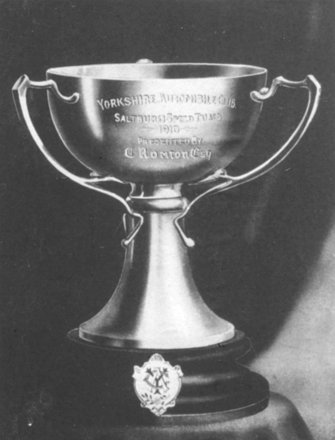
The Routen Cup won
by a 12hp. Star at Saltburn Speed
Trials, 25th June, 1910. |
|
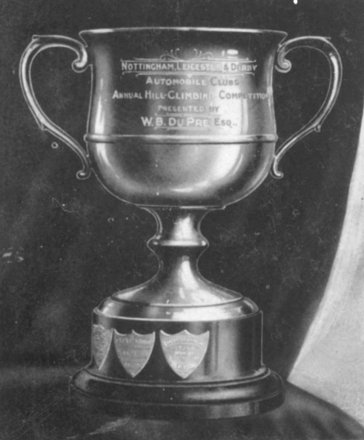
The Du Pré
Cup won by a 15hp. Star in 1909 at the
Leicestershire A.C. Hill Climb. |
|

The Malaga Cup won
by a 12hp. Star at Malaga Auto Fetes. |
|
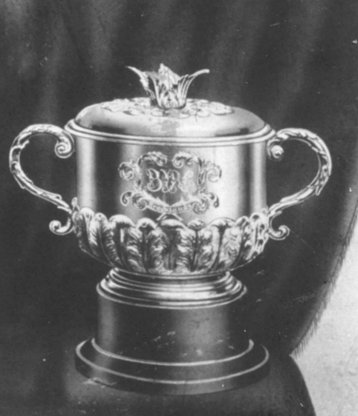
The Brooklands
Senior Handicap Cup won by a 15hp. Star,
16th October, 1909. |
|
|
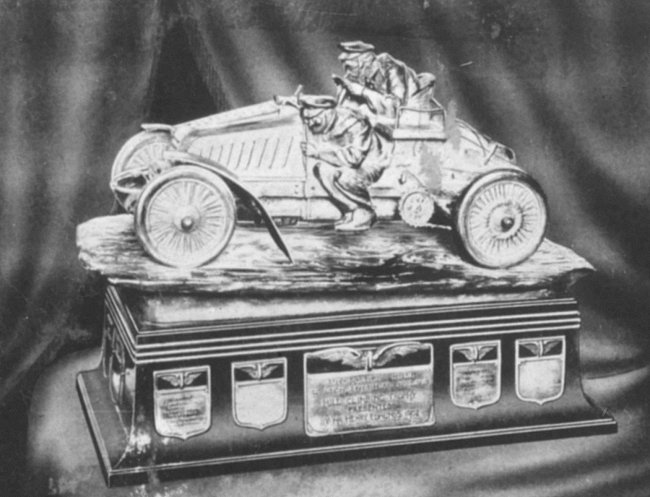
The Henry Edmunds Trophy won
by a 12hp. Star at Shelsley Walsh on 2nd July, 1910. |
|
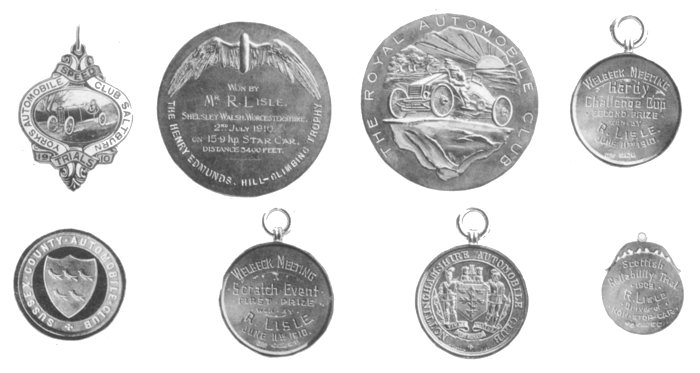
A few of Dick Lisle's medals. |
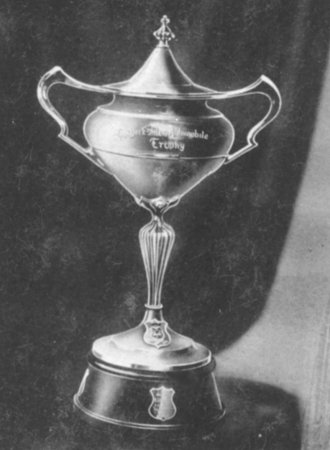 |
The Yorkshire
Automobile Club Challenge Trophy, won on 25th
June, 1910 at Saltburn Speed Trials by a 12 hp.
Star. |
|
A well known Star enthusiast was
Malcolm Campbell, an ex-Star agent. He raced a special
single-seater 11.9hp. narrow-track Star and was
successful in the Easter 1924 meeting at Brooklands,
winning the 75m.p.h. Short Handicap at 73.25m.p.h. and lapping at
79.3m.p.h. He also entered his Star in the 75m.p.h.
Short Handicap (75 Short) in the autumn meeting at Brooklands later that year. As previously, he finished in
first place, crossing the finishing line at 79.5m.p.h. |
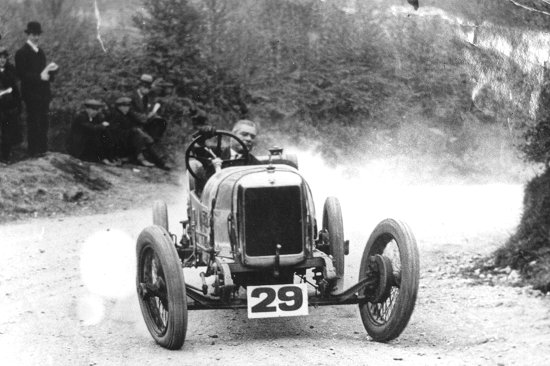
Cecil Cathie driving his Star racing car in
Belfast. Courtesy of Peter Lisle.
|

An advert from 1927. |
In 1923 the 12/25hp. Star, an
updated version of the 11.9hp. car appeared. In May the
following year it evolved into the 12/40hp. car, powered
by a pushrod overhead valve engine, and using the
reliable 4 speed gearbox from the 18/40hp. car.
It was
marketed as Star’s sports model and could achieve 65 to
70m.p.h. with a fully loaded touring body.
Around 1926 R. H. Millington had
some success racing his 12/40 on the sands at several
locations, including Southport.
A two-seater 12/40 owned by Stuart Marr
of Glasgow was entered in the Monte Carlo rally in
January 1928 and finished well up the field after a
trouble free run.
12/40s had numerous successes in
trials and speed events. Two of them, owned by Donald
Monro achieved 70m.p.h. over half a mile at Brooklands.
|
|
Another successful 12/40 belonged
to Mr. Coulter who ran Coulter & Company, the Star agent
in Belfast. He acquired his 12/40 in 1926 and drove it
at a number of racing events in Ulster until he was
severely injured, loosing an arm when the car turned
over. He later had the car repaired, and his employee
Billy Connolly took over the driving. The car had a very
successful racing and trials career at hill climbs in
Ballybannon, and Craigantlet, sand races at Magilligan,
and competitions elsewhere. At one time it was fitted
with the single-seater body from Malcolm Campbell’s
Star. The car still exists today and is now owned by
Brian Rollings.
Read Brian
Rollings'
history of the Coulter Star |
 |
Possibly the last car to be built
by Star was a 14hp. chassis that still survives. It is
known as the McEvoy special and is fitted with a Jensen
two seater sports body. The car was used for the development
of the Zoller supercharger. It is believed to have been
raced by Freddie Hatton at Donnington. |
|
 |
|
 |
|
 |
|
Return to
Take-Over |
|
Return to the
Contents |
|
Proceed to
Star Works |
|
|